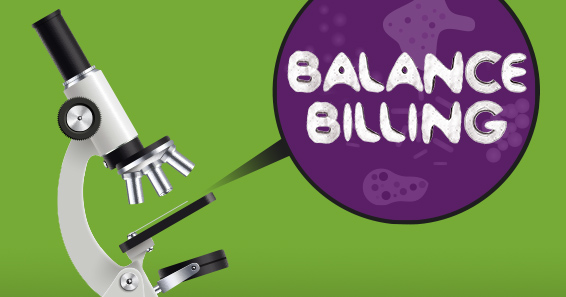Balance Billing Under the Microscope
Growing Concern
For some time now, there seems to be a swell of growing concern regarding the practice of balance billing and especially under the microscope is the ambulance industry- air- and ground-ambulance alike. In some cases, there has arisen an almost villainization of the practice that so many ambulance providers and suppliers rely on to balance already stretched budgets.
 Recent articles and commissioned reports across various platforms have begun to tab balance billing using the phrase “surprise billing.” Comments from patients and families of patients, paint the ambulance industry and, in many cases, the healthcare industry as a whole in an unfavorable light as the industry strives to collect reimbursement beyond what insurance companies are paying.
Recent articles and commissioned reports across various platforms have begun to tab balance billing using the phrase “surprise billing.” Comments from patients and families of patients, paint the ambulance industry and, in many cases, the healthcare industry as a whole in an unfavorable light as the industry strives to collect reimbursement beyond what insurance companies are paying.
8 Ways…
One article published recently caught our eye. The title for this piece published online was 8 Ways the Medical Industry Is Screwing You Over (Livestrong.com 3/1/2019 by Martin Booe.)
It came as somewhat of a shock when the author led with a few paragraphs denoting “Ambulance Rides” as the very first example, in the author’s opinion, of how the healthcare industry is “ripping you off”. The author called the practice “a wallet-ectomy.”
The article pines away by stating; “Back in the old days – 30 years ago – ambulance rides were usually free. Not anymore! Ambulance transports are billed to the patient, whether patients asked for them or not.”
After creating the aspersion that the ambulance industry is fleecing Americans, Booe attempts to balance the discussion by stating that there is a problem citing that Ambulance companies have difficulty collecting for services from both insurers and patients, but then goes on to say that this causes them to “spread the costs” on to others.
Certainly, the article creates a sort of soft indictment of certain segments of the healthcare industry as a whole.
Other “rip-offs” noted in this piece to include what Booe labels; “Crazy Hospital Markups, Physician Burnout, Antibiotics, Faulty Medical Devices, Unnecessary Prostate Procedures, Stents and CPAP Machines.”
GAO Report
Last week the Government Accounting Office (GAO) published report GAO-19-292 in a release of the contents to congressional committees. The report cited that 69 percent of the 20,700 air-ambulance transports they pulled in a representative 2017 sample were found to be out-of-network, compared to 51 percent of ground ambulance transports from a 2014 study of that segment.
In this latest report, the GAO studied over 60 consumer complaints in two of the selected states that were part of the sampling and recorded that all but one of the complaints filed was for a balance bill totaling in excess of $10,000. However, they added that in many cases patients were able to reach agreements with air ambulance provider, insurers or both which resulted in the patient’s paying a lesser amount than represented by the initial bill received.
Additionally, the report mentioned a positive change as figures cited have improved since analyzing the 2017 sample. The GAO found that air ambulance providers are now entering into new network contracts given the recent spotlight on balance billing practices. The report also encourages patients to appeal their bills to insurance companies, citing that ambulance providers and suppliers are more apt to give patients a break on bills when an insurance appeal is unsuccessful.
The GAO noted that recent federal law is requiring the Secretary of Transportation to form an advisory committee to recommend options to prevent instances of balance billing, nationwide.
Brookings Study and counter-argument…
In a February 2019 Center for Health Policy at Brookings report deduced that ambulance services show such a higher incident rate of balance billing over other healthcare disciplines given that those services are “…centrally dispatched and patients almost never have a choice of which ambulance company transports them in an emergency.” Unlike in an emergency situation, a patient can plan on using services which are covered as part of the patient’s in-network insurance plan in a non-emergent treatment or diagnostic scenario.
Certainly, we agree with this analysis. However, we see this as much a problem for the ambulance industry as we do for the patient population. Our duty is to react and respond to the emergency. We do not have the luxury of choosing to practice in populated areas that wholly include patients we can be assured have adequate insurance coverage to balance our budgets.
Additionally, given the aging of America in many parts of the United States coupled with the fact that the entitlement programs (Medicare and Medicaid) admittedly underfund us; it only stands to reason that somehow the shortfalls in EMS agency budgets across the country must be offset in other ways. Costs for providers and suppliers of service must be offset in large by various revenue streams for ambulance agencies to maintain financial solvency.
In the BLS non city world of EMS ambulances cost up to $300,000 fully equipped. This is not including requirements to carry costly Epi auto injectors that have been ridiculously marked up by the pharmaceutical companies. It is my opinion that the blame should be place on the insurance companies and the laws in each state. In Ct policies can not be purchased across state lines. This allows a few insurance companies to only offer what they offer. There is no competition at all. Out of network is a common occurrence.